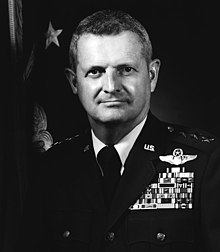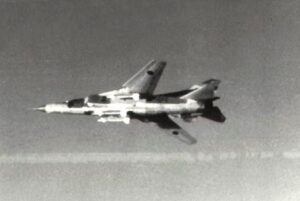26 April 1984 – United States Air Force Lt. Gen. Robert M. Bond (1929–1984), Vice Commander of Air Force Systems Command, is killed in a high-speed ejection from a Mikoyan-Gurevich MiG-23 of the 4477th Test and Evaluation Squadron, out of Groom Lake, Nevada at 1018 hrs., which was initially reported to be an F-117A Stealth fighter. The MiG impacted on Little Skull Mountain on the remote Nellis AFB range in a high-speed 60-degree dive.
 Lt Gen Robert M. Bond joined the USAF in 1951 and flew 44 combat missions in the F-86 Sabre during the Korean War. He flew F-84 Thunderjets, F-86s, and F-100 Super Sabres in Europe, then in 1958 trained at the USAF Fighter Weapons School at Nellis Air Force Base. In 1963 he became chief of the Strike Branch at Kadena Air Base, Okinawa, and flew combat missions over Vietnam in the F-105 Thunderchief.
Lt Gen Robert M. Bond joined the USAF in 1951 and flew 44 combat missions in the F-86 Sabre during the Korean War. He flew F-84 Thunderjets, F-86s, and F-100 Super Sabres in Europe, then in 1958 trained at the USAF Fighter Weapons School at Nellis Air Force Base. In 1963 he became chief of the Strike Branch at Kadena Air Base, Okinawa, and flew combat missions over Vietnam in the F-105 Thunderchief.
After going to Staff College from 1965 to 1966, he served as F-105 and F-111 project officer at Norton Air Force Base, California. From 1968 to 1969 he flew 213 combat missions from Cam Ranh Air Base in Vietnam, in the F-4 Phantom. On 30 December 1968 in Vĩnh Lợi District in the Mekong Delta, Bond, by now a major, made repeated ground attacks in poor weather and under heavy automatic ground fire, for which he won the Silver Star. He was an F-100 instructor pilot at Luke Air Force Base, Arizona, from July 1969 to January 1970, when he was given command of the 310th Tactical Fighter Training Squadron, the first USAF unit to fly the A-7 Corsair. While there, he became director of operations for the 58th Tactical Fighter Training Wing. In 1972 he served a third tour in Vietnam, this time in the A-7.
On 26 April 1984 Bond, who was about to retire, made a farewell visit to “an Air Force Systems Command unit” believed to have been the 6513th Test Squadron, Red Hats, at Groom Lake. The Red Hats, like the 4477th TES Red Eagles based at Tonopah Test Range, clandestinely operated Soviet aircraft. On a previous visit to Groom, Bond had flown the secret YF-117A prototype. The MiG-23 was known as YF-113 in US service and, along with a greater number of MiG-21s, was part of a collection of Soviet-built aircraft that the 4477th flew. Bond insisted on flying the MiG-23 BN fighter-bomber after a cursory briefing over the cockpit rail, even though it was considered a difficult aircraft and pilots usually received several hours of ground instruction before flying it.

On his second high-speed flight, he was flying at 40,000 feet and over Mach 2, and had left the T-38 chase plane that was flying with him far behind, when a hydro-mechanical inhibitor activated, preventing him from disengaging the afterburner. It was designed to avoid sudden shut-downs at high speed that could damage the Tumansky R-29 engine, or even cause it to explode and destroy the aircraft. At such speeds, with the wings fully swept back to 72°, the MiG had very limited pitch authority and was inclined to yaw and roll. Bond lost control, made a distress call (“I gotta get out of here”), and was then killed in the ejection, when the slipstream broke his neck and shredded the canopy of his parachute. The aircraft crashed in the desert, diving in at a 60° angle and impacting on what is now known as Jackass Flats, part of Area 25 that was still contaminated from NERVA nuclear rocket testing years before. Bond’s body was discovered by a USAF sergeant on his way to work, who removed the rank insignia from Bond’s flight suit with a pocket knife before going to get help.
Following this accident, officers of General rank were prohibited from test flying. The Air Force is also forced to admit that it was flying Soviet bloc aircraft. (1)
Source: Wikipedia
